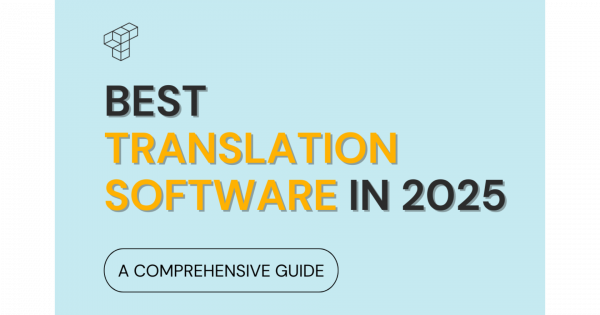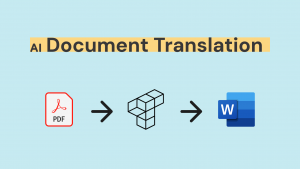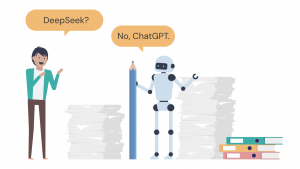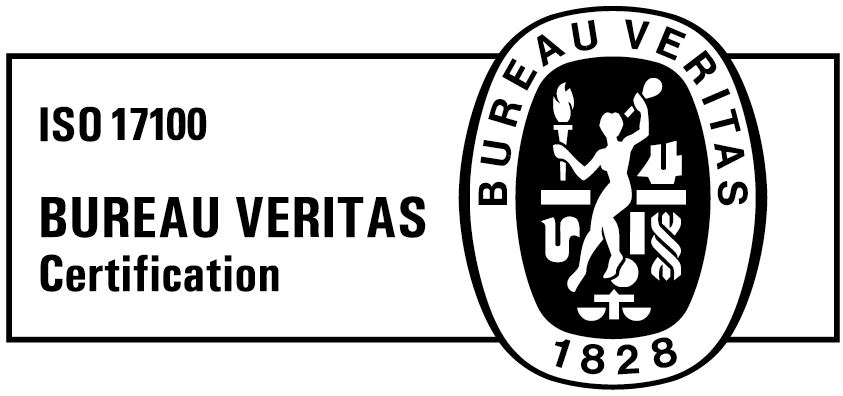-
Eva Legovic
- Estimated reading time: 5 minutes
-
Eva Legovic
- Estimated reading time: 5 minutes
We reviewed and compared publicly available information on 33 best translation software tools— including AI translation tools, LLMs like ChatGPT, hybrid language translation tools with humans in the loop, and full translation management systems (TMS). Our goal was to give you a side-by-side look at pricing and features to help you with your decision-making process.
This is a full translation software list covering 33 tools. Here’s what we evaluated for each tool:
- Free plan – What you get (and what’s limited) before paying
- Pricing – How the paid tiers work: per word, per token, or per seat
- Speed – From instant AI translation to 2-day human review delivery
- Accuracy – Based on real-world use cases, claimed scores, and third-party reviews
- Security – ISO certifications, data storage policies, and privacy features
- Best use case – Who the tool is right for: ecommerce? SaaS? legal? marketing? If you’re specifically working on a cloud-based product, check out the best translation tools for SaaS companies.
Whether you’re exploring the best AI translation software for documents, looking for a reliable and free translation software, or comparing ChatGPT translation quality to tools like DeepL, this guide gives you the context you need to decide — without digging through 33 websites. For more insights into free tools, check out the [comparison of Google Translate, DeepL, and Microsoft Translator].
At the end, you can also jump to an overview of top 3 choices based on your use case, a guide on stress-testing your top choices, and a buyer’s checklist to help you sort through your options quickly in the most effective way.
Type: AI-only, hybrid, or human-first (you choose, project-based)
Best for: Businesses translating full documents — legal, technical, marketing, eCommerce, and more — who need speed, accuracy, and control. The instant AI download with kept formatting as well as a built-in translation editor is perfect for in-house teams, while the human upgrade option allows you to outsource translators on a project-level basis.
Free plan includes: Up to 5,000 words per month for instant AI document translations; upload unlimited files, generate quotes when you want human translators, and translate documents with formatting preserved — no credit card required. You get access to 50 languages and 15 file types.
Paid plan starts at: $10/month for a basic plan, or €8.25 monthly when billed annually. Pro plan starts at $36.58/month when billed annually, and includes access to glossary support, a built-in translation editor, translation memory management, and up to 100,000 words/month with unlimited file uploads. Available languages jump to 189, and 65 available file types.
Speed: Instant for AI; same-day to 48h for human translation projects
Accuracy score: 4.5/5
Pros:
– Supports 189 languages and 65 file types (including PDFs, Word, Excel, PowerPoint, JSON, etc.)
– AI translator takes into consideration the context of your whole document
– Translation memory and glossary support for consistency
– Instant file-based quoting — for when you want professional translation services
– ISO 17100:2015 certified, GDPR compliant, your content is not shared nor used to train the AI model except for your translation memory
– Works without APIs or integrations, but custom solutions and API connections are available (book a demo to discuss)
– No setup necessary, just sign up, upload and go
Cons:
– Not ideal for UI string-based localization (best for documents and text translation), but custom solutions are possible
– No Chrome extension or real-time chat use cases (yet)
Check out this detailed review of Taia’s AI Document Translator to see why it’s one of the best AI translation tools for businesses.
No credit card or verification required.
Type: AI-only
Best for: Quick, casual translations — great for internal chats or informal communication across languages.
Free plan includes: Unlimited web/app use. Supports text, speech, images, websites, and documents (limited formatting).
Paid plan starts at: $20 per million characters (via Google Cloud API)
Speed: Instant
Accuracy score: 3.5/5
Pros:
– Covers 130+ languages
– Extremely fast and accessible on nearly every device
– Supports text, speech, and image inputs
– Available via browser, mobile, and Chrome extension
Cons:
– Very literal translations; context missing
– No control over tone or terminology
– Doesn’t preserve formatting or structure of your documents
– Free version stores translated content for training the AI model
– Not reliable for business-critical or regulated content
Type: AI-only
Best for: Near-natural translation of short-form content in European languages — good for marketing, blogs, and internal docs.
Free plan includes: Translate up to 3 documents/month (non-editable); 1,500–3,000 characters per request
Paid plan starts at: $8.74/month when billed annualy; API pricing from $20 per 1 million characters
Speed: Instant
Accuracy score: 4/5
Pros:
– Often ranked highest for readability
– Custom glossaries and tone selection (formal/informal)
– Document translation with preserved layout
– Great for Germanic and Romance languages
Cons:
– Limited to 33 languages
– No support for many business file types (only .pdf, .docx, and .pptx are available)
– Free version stores content for AI training
– No human review or quality tiers
– Not scalable for teams — lacks collaboration features
Type: LLM (large language model)
Best for: Drafting content, translating creative copy when creativity is more important than accuracy, and multilingual responses inside chat workflows.
Free plan includes: GPT-3.5 with limited memory and no plug-ins
Paid plan starts at: $20/month (ChatGPT Plus with GPT-4 access); API pricing based on tokens
Speed: Instant
Accuracy score: 3.5/5
Pros:
– Extremely flexible — supports almost all languages to a limited degree
– Great for tone adaptation, brand voice prompts
– Custom GPTs can be trained for company-specific language
– Useful for testing tone, clarity, or rewriting translations
– API available for automation
Cons:
– No translation memory or glossary support
– Breaks files or structured document formats
– Not good at processing whole documents in one go; omits, changes, and invents content
– No formatting preservation
– Output varies by prompt and model version and require manual quality assurance
– Data is stored unless using the API carefully
Type: LLM (large language model)
Best for: Long-form translation or rewriting
Free plan includes: Access to Claude.ai (Haiku model) with usage limits
Paid plan starts at: $0.25 per 1 million input tokens & $1.25 per 1 milion output tokens
Speed: Fast (sub-minute)
Accuracy score: 4/5
Pros:
– Handles large file inputs (100k+ tokens in Claude 3 Opus)
– More safety-focused outputs than ChatGPT
– Strong tone and reasoning capabilities
– API allows prompt chaining for translation at scale
Cons:
– Not built for translation specifically
– No TM, glossary, or file format preservation
– Model availability varies by region
– Outputs require manual quality assurance
– Not optimized for localization teams
Type: LLM
Best for: Fast, low-cost translation between Chinese and English — particularly suited for AI builders, hobbyists, and quick localization testing.
Free plan includes: Limited API access (free tokens); open models on HuggingFace
Paid plan starts at: $0.07 per 1K tokens (input); $1.10 per 1K tokens (output)
Speed: Instant (API latency dependent)
Accuracy score: 3.5/5
Pros:
– Strong Mandarin-English support
– Open-source and API-accessible
– Supports tone and structure customization with prompts
– Cost-effective for developers
Cons:
– Accuracy drops outside of English<>Chinese
– No interface for file uploads or document workflows
– No glossary, TM, or review workflow
– Not ideal for business use (limited language support, privacy uncertainty)
Type: AI + human fallback
Best for: Ecommerce teams and site owners who want to launch multilingual websites fast, without coding.
Free plan includes: 1 language, 2,000 words (web translation only)
Paid plan starts at: $18.99 per month per user, no annual billing discount available
Speed: Instant for published websites
Accuracy score: 4/5
Pros:
– Easy setup for WordPress, Shopify, Webflow, and more
– Translates entire websites automatically
– SEO-friendly out of the box
– Includes manual editing interface
– Built-in glossary and language rules
Cons:
– Doesn’t support file uploads or structured content
– No document translation
– Pricing increases steeply with word count
– Can introduce SEO or UX issues if not managed
– No ISO-certified quality levels
Type: Hybrid (AI + human, with integrated TMS)
Best for: Large teams managing web and app localization at scale — ideal for UX strings, mobile content, and multilingual brand consistency.
Free plan includes: No free plan; demo available on request
Paid plan starts at: From ~$0.0075/word for AI; $0.12+/word for AI + human
Speed: Minutes for AI; 1–2 days for human-reviewed content
Accuracy score: 4.5/5
Pros:
– In-context string preview (great for dev teams and UX)
– Supports glossary, translation memory, workflows, and quality assurance
– Built-in translation management system (TMS) with automation, comments, and review layers
– Strong integrations with Figma, GitHub, CMS tools
– Enterprise-grade user and permission management
Cons:
– No public free plan
– Requires onboarding and heavy setup to use effectively
– Pricing isn’t transparent
– Better suited for enterprise users than small teams
Type: Hybrid (TMS + AI + human-in-the-loop)
Best for: Teams managing high volumes of structured content — like product catalogs, technical documentation, or UI files.
Free plan includes: 30-day trial; includes full feature access, TM, glossary, and MT plugin
Paid plan starts at: $29/month (freelancer tier); enterprise pricing available
Speed: Real-time for MT; 24–48h for human workflows
Accuracy score: 4/5
Pros:
– Terminology and memory support
– Pre-translate + AI quality estimation features
– Good automation for repeatable content
– Strong API and repo integrations
– Multi-format file handling
Cons:
– UI is less modern
– Learning curve for teams unfamiliar with translation management systems
– Focused on structured files; not ideal for quick one-off translations
– No standalone human review unless integrated
Type: TMS with AI-powered features
Best for: SaaS, mobile, and dev teams handling UI string localization with engineering pipelines.
Free plan includes: 14-day trial with access to Figma/GitHub/CMS integrations; 500 keys, 2 users, 2 projects
Paid plan starts at: $120/month when billed annually/$140 when billed monthly
Speed: Minutes (depending on file size and AI configuration)
Accuracy score: 4/5
Pros:
– Designed for developers and designers
– Strong versioning and branching tools
– Supports style guides, TM, and glossary
– Over 80 integrations
– Great for continuous localization
Cons:
– Best for strings, not documents
– Pricing starts high for small businesses
– Some features locked behind higher plans
– No built-in upgrade to human quality tiers
Type: Hybrid (AI + human marketplace + TMS)
Best for: Agencies, LSPs, or teams managing translation workflows across freelancers, AI, and internal staff.
Free plan includes: Full platform access with limited MT; pay-as-you-go for freelance linguists
Paid plan starts at: Custom pricing based on usage, hiring, and API
Speed: Instant for AI; varies with human involvement
Accuracy score: 3.5/5
Pros:
– All-in-one TMS with built-in linguist marketplace
– Workflow automation and TM support
– API and integrations for developers
– Flexible pricing model for mixed workflows
Cons:
– Variable quality depending on who you hire
– Complex UI for non-specialists
– Requires freelancer management
– Review processes need manual setup
Type: AI-only (real-time speech-to-text + translation)
Best for: Live events, conferences, and global webinars where spoken translation is required instantly.
Free plan includes: One-time interactive demo of 10 minutes available on request
Paid plan starts at: From $200/month, depending on language and event volume
Speed: Real-time
Accuracy score: 3/5
Pros:
– Provides subtitles and live translation for events
– Integrates with Zoom, Teams, and Webex
– Supports multiple output languages simultaneously
– No human interpreter required
Cons:
– Not designed for written content
– Accuracy depends on audio quality and accent
– Limited customization or brand control
– Not ideal for legal or technical terminology
– Expensive for small organizations
Type: AI-only
Best for: Translating short communications inside Microsoft Teams, Outlook, and Office 365.
Free plan includes: Unlimited use via Microsoft apps; web and speech translation
Paid plan starts at: $10 per 1 million characters (Azure billing)
Speed: Instant for text
Accuracy score: 3.5/5
Pros:
– Built into Microsoft products (Teams, Outlook, Office)
– Supports over 100 languages
– Real-time speech and chat translation
– Developer-ready via Azure API
Cons:
– Translation quality is average — no tone or style customization
– No TM or glossary support
– API pricing can be opaque
– Not ideal for document workflows or reviewed content
– Lacks industry-specific accuracy
Type: AI-only (Neural machine translation via AWS)
Best for: Translating product data, support content, or ecommerce metadata via API at scale
Free plan includes: 2 million characters/month for 12 months via AWS Free Tier
Paid plan starts at: $15 per million characters
Speed: Sub-second via API
Accuracy score: 3.5/5
Pros:
– Scales well for high-volume use
– Integrated with AWS ecosystem
– Simple pricing, fast processing
Cons:
– No UI or built-in editor
– Requires technical setup
– No formatting, glossary, or tone control
– Not ideal for unstructured or creative content
– No human fallback option
Type: Hybrid (TMS + machine translation + human review)
Best for: Enterprise teams that need full localization workflows, document uploads, and optional MTPE (machine translation post-editing).
Free plan includes: Self-service trial with file upload; basic TM/glossary access
Paid plan starts at: €599/month for basic enterprise plan (includes 5,000 words/month, 10 PDF uploads, and 5 users)
Speed: MT in minutes; human review 24–72h
Accuracy score: 4/5
Pros:
– Offers MT, human post-editing, and full project management
– UI includes reviewer feedback, QA checks, and file approval steps
– Supports glossary, translation memory, and CMS integration
– File upload works with PDFs, DOCX, Excel, and more
– Built-in reporting and billing controls for large orgs
Cons:
– High pricing threshold
– Lacks real-time API usability for developers
– Not ideal for small teams or one-off translations
– AI translation quality lags behind newer LLMs
Type: LLM (powered by OpenAI)
Best for: Marketers and content creators looking for quick translation alongside AI writing and repurposing.
Free plan includes: Up to 2,000 words/month for translation and copy generation
Paid plan starts at: $36/month (includes unlimited words and projects)
Speed: Instant
Accuracy score: 3/5
Pros:
– Great UI for writing + translating content in one place
– Offers translation within broader copywriting flows
– Ideal for marketing teams using English + one or two languages
– Can maintain tone/voice with prompt input
– Includes team collaboration features
Cons:
– Translation accuracy is average — not built for it
– No glossary, TM, or translation memory features
– Formatting is stripped
– No document upload — text-only workflow
– No upgrade path to reviewed translation
Type: LLM (Google’s Bard successor)
Best for: Google Workspace users and devs needing AI-powered translation + productivity features inside Gmail, Docs, and Sheets.
Free plan includes: Web-based access to Gemini 1.5 Pro; basic features via Gmail/Docs
Paid plan starts at: API pricing starts at $0.075 per 1K input tokens
Speed: Fast
Accuracy score: 3.5/5
Pros:
– Integrated with Google ecosystem
– Smart for rephrasing or translating informal content
– Expanding support for long prompts and structured input
– Available via Workspace + mobile
Cons:
– Not built for translation workflows
– Lacks TM, glossary, or formatting support
– Cannot export structured files
– Translation performance is variable
– Not suitable for regulated or formal documents
Type: AI-only (optional on-premise or secure deployment)
Best for: Enterprises in regulated industries (legal, government, finance, healthcare) that need tight control and custom deployment.
Free plan includes: 14-day Translate Pro trial (includes glossaries, batch uploads, formatting support)
Paid plan starts at: $9.99/month (Pro); on-premise/server plans priced separately
Speed: Fast online translate; varies for on-prem or server installs
Accuracy score: 4/5
Pros:
– Glossary and memory customization
– Secure, offline-ready deployment
– Batch document translation with format preserved
– Popular in high-security sectors
Cons:
– Interface feels outdated
– High setup costs for secure deployments
– No collaborative workflows
– Limited language expansion
– Lacks ease-of-use for SMBs or non-technical teams
Type: Hybrid (AI + human editing)
Best for: Customer service teams handling multilingual support — especially via CRM and email systems.
Free plan includes: None; demo available
Paid plan starts at: From $0.0002/word (chat); tiered pricing for email/support
Speed: Seconds for AI; 1–2 hours for human-edited content
Accuracy score: 4/5
Pros:
– Built for Zendesk, Salesforce, and HubSpot
– AI + human workflow built-in
– Supports brand voice and review layers
– Usage-based pricing
– Real-time support translation
Cons:
– No file translation or document support
– Not for marketing, legal, or technical content
– Pricing gets expensive with high volume
– Requires integration setup
Type: AI writing assistant with translation
Best for: Students or casual users translating short phrases and improving grammar, structure, or tone.
Free plan includes: Access to paraphraser and basic translator (limited features)
Paid plan starts at: $19.95 monthly, or $39.95 quarterly
Speed: Instant
Accuracy score: 2.5/5
Pros:
– Easy for paraphrasing + translation in one
– Great for ESL learners or students
– Includes grammar checker and co-writing tools
– Popular in academic circles
Cons:
– No glossary, TM, or terminology tools
– Not accurate for professional translation
– Doesn’t support file uploads or long text
– Output quality is inconsistent
– Not designed for business or regulated use
Type: NMT (Neural Machine Translation) + writing/editor AI
Best for: Students, researchers, and academic professionals who want automated translation + editing support.
Free plan includes: Translate and edit up to 5,000 words/month
Paid plan starts at: Premium plan (price not publicly listed)
Speed: Near real-time
Accuracy score: 3.5/5
Pros:
– Includes paraphrasing, grammar, and translation tools
– Supports academic tone and citation-friendly style
– Helpful for post-editing machine-translated documents
– Focused on research and scholarly publishing
Cons:
– Not designed for structured document translation
– No file upload (text box input only)
– No glossary or terminology control
– No ISO or business-ready certifications
– UI is more student-focused than enterprise-friendly
Type: NMT
Best for: Users looking for simple, fast, no-login translation — with optional privacy guarantees.
Free plan includes: 40 Fast Credits/day (roughly 1,200–1,600 words), up to 1,500 characters per translation
Paid plan starts at: $7.90/month (Fast plan); higher for full usage
Speed: Fast
Accuracy score: 3/5
Pros:
– Free and minimal interface
– No login or data storage required
– Claims not to train on user data
– Good for translating short passages or single documents
Cons:
– Limited control over formatting or style
– No glossary or tone adjustment
– Not built for teams or structured use
– Doesn’t scale for large projects or business content
Type: TMS + CAT tool
Best for: Professional translation teams managing termbases, reviewer roles, and large localization projects.
Free plan includes: Trial version for freelancers or teams
Paid plan starts at: Custom quote (based on seats + integrations)
Speed: MT = minutes; reviewed = 24–48h
Accuracy score: 4/5
Pros:
– Industry-leading CAT features and memory control
– Ideal for legal, medical, and technical translation teams
– Workflow automation, segment QA, and terminology rules
– Strong file support and format preservation
Cons:
– Requires training and setup
– Not accessible for casual users or one-time projects
– No free-forever version
– Human review requires external sourcing or agency link
Type: Aggregator + AI review
Best for: Comparing output from multiple machine translation engines and routing to human review when needed.
Free plan includes: Translate up to 100,000 words/month; includes side-by-side MT comparison
Paid plan starts at: $12.75/month
Speed: Instant
Accuracy score: 4.5/5
Pros:
– Shows results from multiple engines (DeepL, Google, etc.)
– Automatically scores each result for quality
– Offers MTPE (post-editing) with freelancers
– Ideal for choosing the best AI output at scale
Cons:
– Doesn’t support formatting or file upload
– UI can feel technical for non-linguists
– Not ideal for one-click workflows
– No ISO or formal QA levels
Type: AI-assisted TMS
Best for: Product and mobile app teams managing continuous localization for strings and updates.
Free plan includes: 200 managed source keys, unlimited usage
Paid plan starts at: $49/month
Speed: Fast; designed for CI/CD localization
Accuracy score: 3.5/5
Pros:
– Built for devs with repo integration
– Supports in-app translations and OTA updates
– Great for fast-moving release cycles
– Offers MT suggestions with glossary fallback
Cons:
– Not ideal for documents or business materials
– Limited in-built quality control
– MT not always customizable
– Pricing scales quickly with usage
Type: AI-assisted web plugin
Best for: Quickly translating public-facing websites without dev help.
Free plan includes: 15-day free trial with full plugin access
Paid plan starts at: $50/month
Speed: Instant after setup
Accuracy score: 3.5/5
Pros:
– Easy for marketers and non-tech users
– SEO-ready and built for fast deployment
– No-code installation (JS snippet)
– Works with CMS and landing page builders
Cons:
– Doesn’t support document uploads
– Not built for legal, technical, or internal content
– No glossary or terminology enforcement
– MT engine isn’t adjustable
– Review/editing is manual
Type: Hybrid (full-service LSP)
Best for: Enterprise content localization at scale — especially for legal, technical, or regulated industries.
Free plan includes: None, but free onboarding & workspace trial
Paid plan starts at: ~$0.20/word (varies by service tier)
Speed: Typically 1–3 business days
Accuracy score: 4/5
Pros:
– High-quality human translation services
– Deep expertise in regulated sectors
– Scalable for global content ops
– Custom workflows and QA options
Cons:
– No instant quoting or upload
– Requires manual project kickoff
– Expensive for smaller teams
– No access to platform without sales contact
Type: Hybrid (AI + human)
Best for: Translating marketing, internal, or creative content with high quality and fast turnaround.
Free plan includes: No public free plan; demo available on request
Paid plan starts at: $0.12/word
Speed: Typically under 24h (standard); faster for urgent orders
Accuracy score: 4/5
Pros:
– Built-in translation memory and glossary
– Offers both AI and human workflows
– Strong customer support
– Accepts a variety of file types
Cons:
– Pricing can vary widely by language pair
– No self-serve quoting or upload system
– Not suited for technical integrations
– No instant delivery for AI-only content
Type: Hybrid (LSP with MT and human services)
Best for: Enterprises needing a full localization partner — including language services, testing, and design.
Free plan includes: None (custom onboarding only)
Paid plan starts at: ~$0.15/word
Speed: 1–3 business days depending on tier
Accuracy score: 4.5/5
Pros:
– Full-service support, from copy to QA to UX testing
– Works with many global brands
– Secure, ISO-certified processes
– Scalable to high-volume needs
Cons:
– Limited self-service
– Manual handoffs and onboarding
– Pricing and delivery hidden until scoping
– No instant or AI-only tier for fast content needs
Type: Hybrid (freelancer platform + AI)
Best for: SMBs looking for content translation (ecommerce, legal, blogs) with optional human quality levels.
Free plan includes: Limited-time free trials
Paid plan starts at: $0.088/word (standard, simple translation)
Speed: 24–48h
Accuracy score: 4/5
Pros:
– Easy interface and fast onboarding
– Pricing scales by quality level
– Offers proofreading, content writing, and MTPE
– Supports multiple file formats
Cons:
– No free tier
– Not ideal for internal docs or B2B technical files
– AI-only translation not accessible separately
– Limited QA controls for higher-stakes content
Type: Hybrid (crowdsourced human + basic MT)
Best for: Fast, low-cost human translation — especially for short-form content, ecommerce, and customer communication.
Free plan includes: Demo access only
Paid plan starts at: $0.06/word (standard tier); $0.12/word (pro)
Speed: ~24 hours for standard orders
Accuracy score: 3.5/5
Pros:
– On-demand human translators across 70+ language pairs
– Transparent pricing
– Simple UI for file or text input
– Quick turnaround for small projects
– Scales well for short-form use cases
Cons:
– No AI-only tier or automation
– Formatting and layout not preserved
– No glossary or memory support
– Inconsistent quality in standard tier
– No upgrade path for ISO-level review
Type: AI-assisted TMS
Best for: Developers managing localization for web, mobile, and software products — especially with Git-based workflows.
Free plan includes: 1 project, 2 collaborators, basic string workflow
Paid plan starts at: $50/month (Team plan); custom enterprise plans
Speed: Real-time for string-based content
Accuracy score: 4/5
Pros:
– Excellent for continuous localization
– Git, GitHub, Bitbucket, and CLI support
– Supports TM, glossary, and in-context previews
– Strong API for workflow automation
– Figma and design tool integrations
Cons:
– Not built for structured documents
– UI can be overwhelming for non-dev users
– Setup requires some technical knowledge
– No human-in-the-loop translation options
Type: Hybrid (AI-powered + human translation services / TMS features)
Best for: Enterprises and developers needing AI-first localization at scale.
Free plan includes: Instant quotes and access to TranslationOS and Lara AI demo
Paid plan starts at: ~$0.11 per word
Speed: AI/text output in seconds, human service project dependent
Accuracy score: 4/5
Pros:
– Covers 200+ languages
– Supports modern file formats and multimedia (text, audio, video)
– Features adaptive machine translation (ModernMT + Lara), translation memory, glossary tools
– Enterprise-grade security with ISO 27001 certification
– Offers hybrid workflows with human QA and TAL network
Cons:
– No permanently free plan after trial; pricing requires contacting sales
– Mixed reviews for human translations
– Limited autonomy for small teams—enterprise focus may make setup heavy
– No one-click lightweight document translation interface (more workflow driven)
Quickly match the best software for translation depending on what you’re working on.
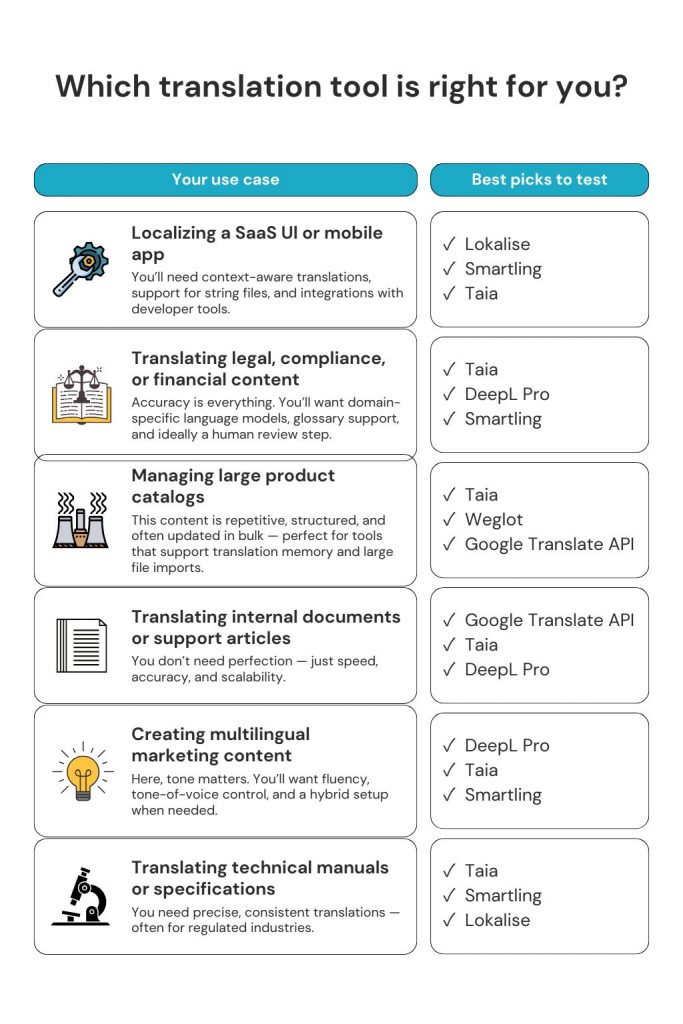
You’ll need context-aware translations, support for string files, and integrations with developer tools.
Best picks:
- Lokalise – built for dev teams, supports string keys, branches, and live previews
- Smartling – great for complex workflows and multiple teams
- Taia – good if you want to upload exported UI files and reuse translations through TM
Accuracy is everything. You’ll want domain-specific language models, glossary support, and ideally a human review step.
Best picks:
Taia – supports legal translation memory, ISO-certified workflows, and hybrid options
DeepL Pro – solid fluency, but should be paired with human review for important content
Smartling – enterprise-ready for teams with regulated content
This content is repetitive, structured, and often updated in bulk — perfect for tools that support translation memory and large file imports.
Best picks:
Taia – excels at reuse with context-aware AI that learns from your translation memory, and batch processing, plus human review options available
Weglot – good for quickly launching multilingual sites
Google Translate API – useful for internal systems, product feeds, or databases
You don’t need perfection — just speed, accuracy, and scalability.
Best picks:
Google Translate API – cheap, fast, and reliable for internal use
Taia – can handle bulk uploads and auto-saves for future reuse
DeepL Pro – great if your team prefers polished output without editing
Here, tone matters. You’ll want fluency, tone-of-voice control, and a hybrid setup when needed.
Best picks:
DeepL Pro – some of the most natural language output
Taia – combine AI with human editing to maintain voice
Smartling – strong for campaign localization at scale
You need precise, consistent translations — often for regulated industries.
Best picks:
Taia – supports structured files, terminology enforcement, and domain-specific memory
Smartling – built for complex content across multiple products
Lokalise – works well if content is structured as strings
You have more specific needs than that?
Taia’s team is flexible enough to offer custom solutions tailored to your needs.
So, you’ve found a few AI translators that look promising. Nice. But before you commit to anything — even a free plan — take 15 minutes to stress-test them properly.
Here’s how to run a smart side-by-side evaluation that actually tells you what you need to know.
Choose a sample that reflects what you typically translate — because translating a generic paragraph won’t show you how the tool handles real-life complexity. Use things like:
- A legal contract or NDA
- An exported UI string set
- A spreadsheet with product info
- A marketing email or landing page
This helps reveal how the tool handles structure, terminology, and tone.
1. Formatting and layout
- Does it preserve your original DOCX, PPTX, or Excel layout?
- Can it keep bullet points, tables, or headers in place?
2. Terminology and tone
- Does it consistently translate key phrases like “customer onboarding”?
- Does it sound like your brand or like a clunky word-for-word conversion?
- Can you lock terms via glossary?
3. Speed vs. quality
- Is it lightning fast? Great — but is it correct?
- Would you send the result to a customer without edits?
- Is there an upgrade path to human review if needed?
4. Translation memory
- Does the tool remember previous translations and reuse them?
- Or does it start from scratch every time?
5. Collaboration and handoff
- Can you invite your reviewer or local partner?
- Is there commenting, change tracking, or version history?
- Can you manage glossaries or TM centrally?
- You can’t upload your file type
- The UI feels outdated or confusing
- No glossary, TM, or preview features
- No clarity on pricing or usage limits
- You’re forced into a sales call just to try the thing
Some tools are “free to try,” but once you dig in:
- They limit characters or strip formatting
- They hide important features like glossary or file export
- They may even store your data to train their models
So always ask:
Is this tool really free to use — or just free to test?
💡 Pro tip: Use your free trials to build a small “translation sample set.” A few files you can reuse across vendors — so you’re comparing apples to apples, not just shiny interfaces.
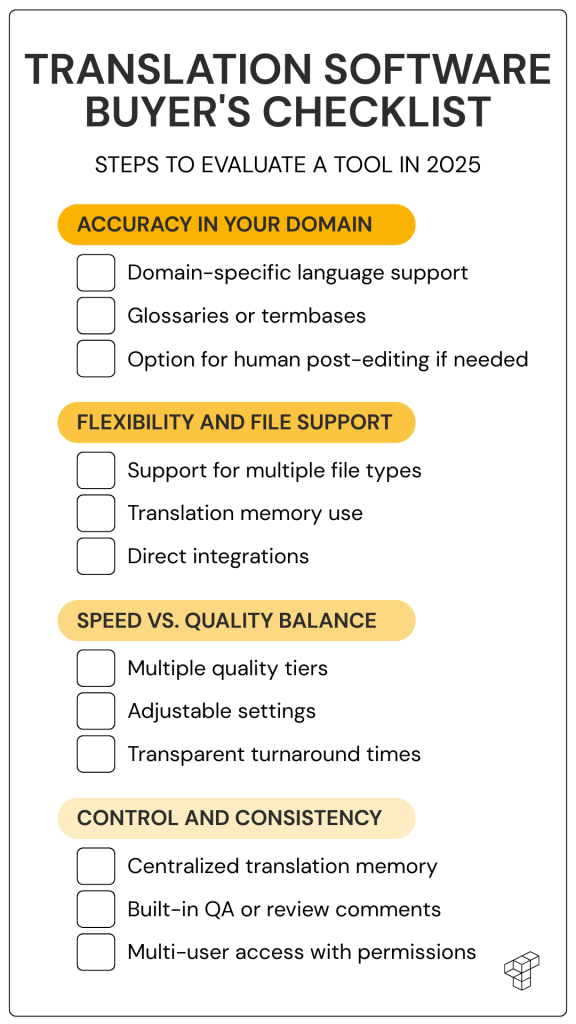
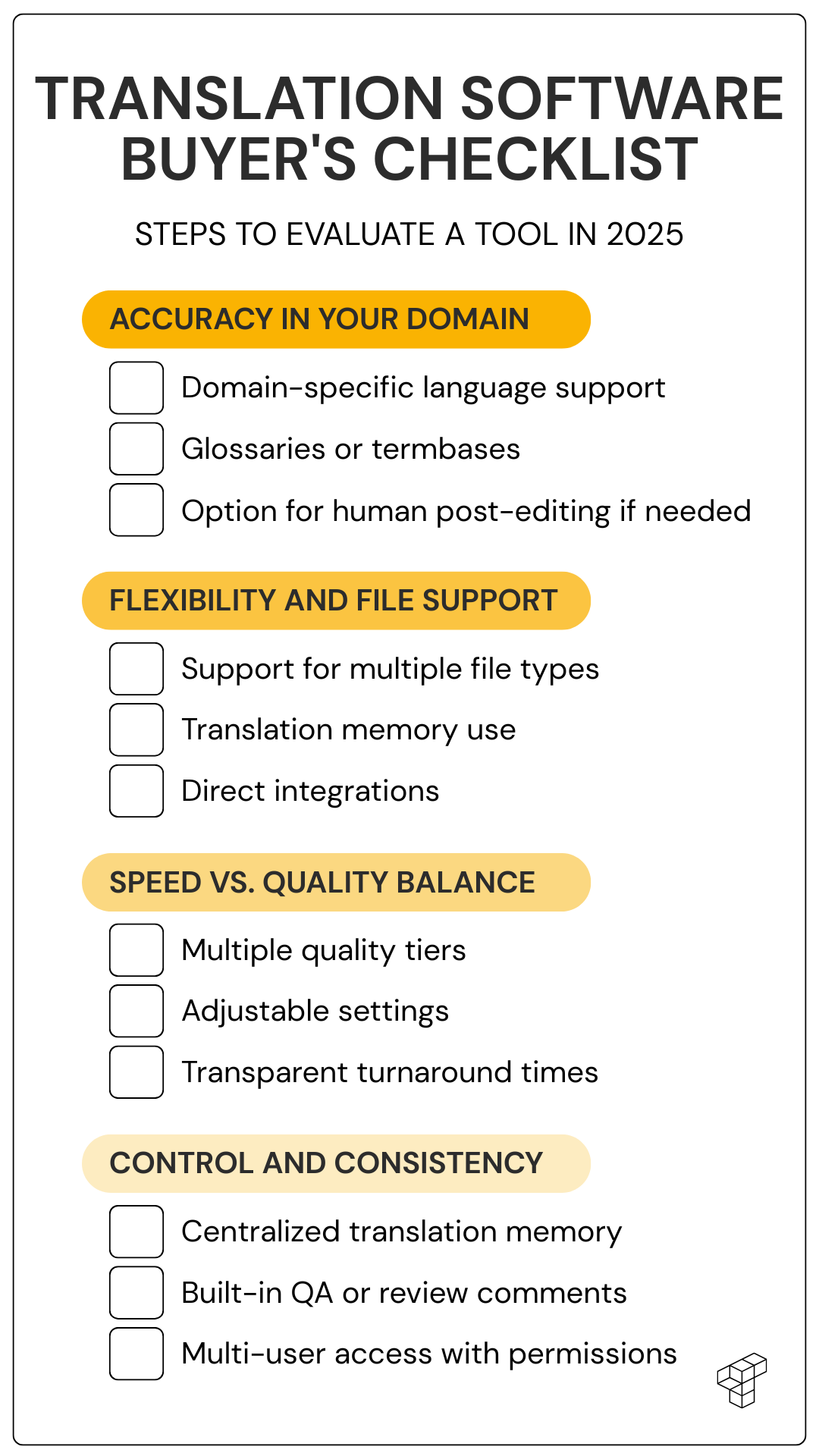
You don’t need to compare 33 tools line-by-line — just make sure your top pick checks these 5 boxes:
Can the tool handle your industry-specific content?
Whether it’s marketing copy, legal contracts, UI strings, or technical manuals — you need translations that actually make sense.
Do you have control over key phrases, product names, or compliance terms?
If your “customer onboarding guide” becomes “client warm-up story”… you’ve got a problem.
Can it handle the formats you actually use — like Word, Excel, PowerPoint, PDFs, JSON, etc.?
Bonus points for tools that preserve formatting (so you’re not redoing layouts later).
Is it fast enough for your team… but also smart enough for big projects?
Look for batch uploads, translation memory reuse, and automation (or human fallback) when you need it.
Does it meet your standards — and your legal team’s?
Look for:
- ISO certification
- GDPR compliance
- Clear data policies
- Optional human review
Taia checks all five boxes.
Go from AI draft to human-edited output in one workflow.
Frequently asked questions
Which is the best software for translation?
It depends on what you’re translating. If you’re handling documents, legal content, or structured files, tools like Taia offer better results — with glossary control, formatting support, and optional human review.
For casual use, tools like Google Translate or DeepL Free are fast and easy.
Need full localization workflows and budget is not an issue? Consider Lokalise, Smartling, or Phrase TMS.
What is the best AI for legal translation?
Legal translations require precision, consistency, and confidentiality — not just speed. Taia is one of the best tools in this space, with ISO-certified workflows, built-in glossary and TM support, and a secure environment for sensitive documents.
Other options like Trados Studio and Smartling also support regulated content, but are heavier to set up.
Avoid using consumer tools like Google Translate for legal content — even minor errors can have major consequences.
Is there a better tool than Google Translate?
Yes — in many cases.
Google Translate is great for speed and convenience, but it lacks nuance, formatting preservation, and context awareness.
Taia and DeepL both offer more fluent results, better control over terminology, and stronger document handling.
If you’re translating business documents, product content, or anything customer-facing, a more specialized tool like Taia will give you better results.
Can you use AI to translate?
Absolutely. AI translation tools are widely used today — for everything from emails and support articles to legal contracts and product catalogs.
The key is choosing the right tool for your use case.
If speed is your top priority above accuracy, free tools like ChatGPT or Google Translate work for quick drafts.
But if accuracy, consistency, or formatting matter, opt for professional-grade tools like Taia, which supports 189 languages, 65 file types, and lets you upgrade to human review if needed.
Is ChatGPT good for translation?
It’s decent for casual content and fast drafts.
ChatGPT can translate text and adapt tone — especially when prompted correctly.
But it’s not built for documents, file uploads, glossary enforcement, or formatting.
For that, a tool like Taia is more suitable and accurate.
What’s the best AI translator for business documents?
If you’re working with Word, Excel, PDFs, or structured marketing and legal content, Taia is one of the top choices.
It supports 189 languages, preserves formatting, applies your glossary/translation memory, and lets you upgrade to human review — all in a secure, ISO-certified environment.
Other solid tools include TextUnited, Smartling, and Phrase TMS, but they’re often more expensive or harder to onboard.
Is DeepL still better than Google Translate?
Yes — in most cases.
DeepL offers more natural phrasing, especially in EU languages, and supports glossaries and tone selection.
But Google Translate covers more languages (130+) and has better real-time integrations.
For formatted documents and brand consistency, though, neither beats Taia Translate.
What file types can I translate with AI tools?
This varies a lot by platform.
Some tools (like ChatGPT and Google Translate) only support plain text or website input, with some document processing capabilities.
Others — like Taia — support over 65 file types including DOCX, XLSX, PPTX, PDF, InDesign, JSON, and XML.
If you’re working with formatted documents, always choose a tool that preserves layout and supports direct file upload (like Taia).
Are AI translation tools secure for sensitive content?
Only some of them.
If you’re translating legal, HR, or financial content, make sure the tool is ISO-certified, GDPR-compliant, and doesn’t use your content to train their AI.
Taia, Smartling, and Lokalise all meet enterprise-grade standards.
Avoid free browser tools unless they explicitly guarantee data privacy and storage control.
What does “free” mean in AI translation?
“Free” varies widely.
Some tools give you free access with usage limits (e.g. Taia offers 5,000 words/month with formatting and glossary support).
Others give you free access but store your data or strip key features like file uploads or glossary tools.
Always check whether the free plan actually supports your file type, formatting, and required output — and whether your data is being stored or shared.
What’s the benefit of hybrid translation over traditional methods?
Hybrid translation combines AI translation with human editing. You get the speed of AI plus the quality of a pro translator. It’s faster and more affordable—without sacrificing accuracy (especially if you’ve got a solid TM and glossary backing it up).
What is the most accurate translator tool?
For fluency in European languages, DeepL Pro consistently ranks highest.
For technical, legal, or high-stakes documents, Taia offers better control with glossary locking, ISO-certified workflows, and human revision options.
ChatGPT, while powerful, can hallucinate or skip content, so it’s best used with human oversight.
Is ChatGPT or DeepL better?
It depends on the task.
DeepL is more accurate for direct translation, especially in European languages.
ChatGPT is more flexible — it can adapt tone, rewrite content, or follow stylistic prompts — but it’s less reliable for file formatting and consistency.
For business use, a tool like Taia blends both worlds: AI speed + human-quality review + document support.
What is the number 1 translator app?
There’s no single winner — it depends on your use case:
- For full documents with formatting: Taia Translations
- For quick mobile/text: Google Translate
- For shorter European translation: DeepL
- For real-time speech: Wordly or Microsoft Translator
What is the best AI translator in 2025?
The best AI translator in 2025 depends on your needs—whether you prioritize speed, file support, or human-quality accuracy. Tools like Taia, DeepL, and Google Translate dominate, but platforms offering AI + human translation (like Taia) are increasingly preferred by businesses.
What are the best AI tools for translation right now?
Some of the best AI tools for translation include Taia, DeepL, Google Translate, and Microsoft Translator. Each offers unique strengths—Taia stands out for its glossary support, document translation, and built-in upgrade to human review.
Where can I find a full translation software list?
Right here! Our blog compares 33 top translation software tools side by side—including AI-powered and hybrid options. From free platforms to pro-level business solutions, you’ll find a comprehensive translation software list with all the essentials.
What’s the top translation software for business use?
Top translation software for business typically includes Taia, Smartling, Phrase, and Lokalise. Features like Translation Memory, file support, and team collaboration tools make them ideal for fast-moving teams.
What’s the best LLM for translation tasks?
Large Language Models (LLMs) like GPT-4 and Meta’s NLLB are pushing the boundaries of translation. Taia uses AI enhanced by domain-specific translation memory—offering a smarter alternative to generic LLM outputs, especially for business content.
